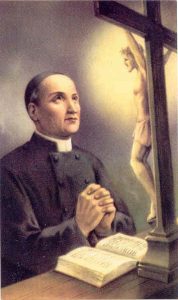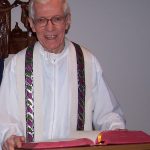ACCOUNT ON FABRO SYMPOSIUM
April 1st-2nd, 2016
Catholic University of America, Washington, D.C.
A “Cornelio Fabro Symposium” was held in Aquinas Hall, Catholic University of America, in Washington DC, from April 1st-2nd, 2016. An American Stigmatine confrere was chosen by the organizers, to present a few thoughts from contacts in Rome with Father Fabro. This “Fabro Symposium’ was organized by the ’Cornelio Fabro Cultural Project’ for the sake of bringing more and more students in this young 21st century, to an appreciation of the treasure that the Stigmatine, Father Fabro, has been for the Church through much of the 20th Century and beyond.
The “Cornelio Fabro Cultural Project” was founded on April 11, 2002, by the Superior General of the Institute of the Incarnate Word [founded in Argentina], Father Carlos Miguel Buela. This group has as its immediate aim the diffusion of the thought and works of Fr. Cornelio Fabro. On March 7, 2004 the “Project” was officially presented together with the publication of the first volume of the Complete Works of Fr. Fabro. Presently 22 volumes of the 100 planned volumes have been published. In 2011 the “Cultural Project” actively collaborated in the organization of different initiatives for the celebration of the centenary of Fabro’s death [August 24, 1911-May 4, 1995].
Father Joseph Henchey, CSS participated in the Introductory Panel, and submitted an article for the Symposium. The title of this study is “Father Cornelio Fabro- A Stigmatine – Devoted to his Founder.” From initial studies of Fr. Fabro’s voluminous works, it seems that the following phases of development took place in Father Fabro’s brilliant mind:
[1] Early Studies in the theology of St. Thomas – the doctoral thesis of the young Father Fabro has since become a classic in the Thomistic world. This is his lasting work on ’Participation” – a major contribution to the understanding of the thought of St. Thomas Aquinas.’
[2] Mature Research: Through the war years and beyond, Father Fabro learned Danish in order to translate some of the extensive works of Soren Kierkegaard, a Danish Lutheran writer, often dubbed ‘the melancholic Dane!’ In more recent times, however, Kierkegaard has become an important ally to Catholic theologians. Some modern readers are suspicious, if not dismissive of Kierkegaard. However, the favorable mention of Kierkegaard by Pope St. John Paul II’s Letter on Fides et Ratio offers a further reason why Kierkegaard cannot simply be rejected out of hand. Father Fabro maintained that he had learned as much from Kierkegaard as he had from St Thomas Aquinas!
These scholarly studies led Father Fabro to study in great depth the phenomenon of modern atheism, now appearing in English Translation as “God in Exile” [Newman Press 1968, translated by the Canadian scholar Arthur Gibson – with an enthusiastic Foreword composed by the renowned scholar, John Macquarrie.
[3] Spiritual Fulfillment – these would Fabro’s Vatican II years and beyond, 1965-1995. He was appointed to be one of the Consulters in preparation for the Council. In this period, his fertile pen produced some truly extraordinary works: Prayer in Modern Thought; Gemma Galgani a Witness of the Supernatural [Published by the Passionist Congregation]; Times of the Spirit [2 volumes published by the Franciscans of Assisi.
Father Henchey translated three fine, substantial studies of Father Fabro regarding St. Gaspar Bertoni:
- An Ecclesial Priest: Blessed Gaspar Bertoni [1982];
- Gaspar Bertoni: Witness of the Supernatural [presented at Bertoni Symposium, Angelicum University Rome, October 28, 1989];
- Gaspar Bertoni: A life illumined by the Supernatural [published posthumously in 2009].
In his paper presented to the Symposium, Father Henchey offered a brief outline of St. Gaspar Bertoni’s life and spirituality. Father Fabro – no stranger to physical suffering himself – was deeply moved by the fact that from perhaps the age of 45 until his death at 76, St. Gaspar suffered atrociously and almost daily from poor medical treatment and the deterioration of a leg fistula that eventually developed into cancer. The Founder’s long years of immobility also brought on very serious and painful bed sores, along with severe arthritis
There is an unusual parallel in Kierkegaard’s dates – 1813-1855 – with St. Gaspar being at the Stimmate, 1816-1853. While they were contemporary, there is no indication that they had ever known each other; there is nonetheless a striking consonance of some spiritual principles shared by Father Bertoni and Kierkegaard.
Several key texts from Father Bertoni’s Spiritual Diary for Father Fabro would be these three:
[1] [Spiritual Diary] MP – July 30, 1808: [St. Gaspar’s Spiritual Model: [Assimilation – Communion – ‘Con: Suffering (Col 1:24) Crucified; Buried; Risen’] – Copy – Example – Filiation – Following/ Imitation – Heir – Inheritance – ICON: Col 1] – One Life – Recapitulation – Martyr – Union (GS 22) – Witness, etc.] – on the Feast of St. Ignatius of Loyola],
[17.] For the examination of conscience one should choose a Saint of the same vocation as a mirror. In this way one finds matter for confession every day. Whatever falls short of that Saint’s perfection is faulty…
[2] MP – September 15, 1808: [Apostolic Influence of St. Ignatius]
[41.] Introduction to the Spiritual Exercises. While visiting the altar of St Ignatius with my companions I felt much devotion and recollection with great inner cheerfulness and some tears – even though the visit was short. I had the feeling that the Saint was welcoming us and inviting us to work for the greater glory of God as he did. To work in the same ways: though not using all those means [‘modi’] that he was able to use. He seemed to tell us: “Onward, soldiers of Christ! Gird yourselves with fortitude! Pick up the shield of faith, the helmet of Salvation, the sword of the divine Word and fight against the “ancient serpent”. Make my spirit alive again in you and in others through you”.
[3] MP – October 9, 1808: [St. Gaspar’s 31st birthday] – A Eucharistic, Trinitarian Spirituality
[59.] Feast of St Denis and the Maternity of the Virgin Mary.
During the Eucharistic prayer of the Mass near the time of the memento, it seemed that my mind opened up to know with Whom was I speaking. I felt great affection and an enthusiasm of love in prayer. Then some outbursts of my heart for God and some impulses of my spirit towards God. I seemed to be like a person overwhelmed by the appearance of a great friend who had not been seen for a long time and on seeing him suddenly, he wants to throw himself at him and embrace him. Then I felt a desire that the vision could increase and an impulse to be able to reach the Supreme Good. Since I was in public I feared [the feeling of] some vanity and I [made an effort to] think of my most serious sins. As a consequence [I felt] an increase of knowledge of goodness and love which dissolved in most soothing tears which lasted until after Holy Communion. In the meantime, faith and confidence increased very much together with humility and loving reverence. Lastly, at Communion, a very intense devotion and sentiment similar to that of my First Holy Communion: an experience that I am not aware of having felt since. The recollection lasted for another hour and it remained for the rest of the evening.
A contribution from S. Kierkegaard for Father Fabro’s understanding of his saintly Founder:
Contemporaneity: A life-long influence for Father Bertoni was his daily sufferings from the age of 45 until he was 76, when he died.
There is, then this consonance of Kierkegaard with Fr. Bertoni which goes back to their common font, the New Testament. Furthermore there are traces of common readings of Catholic mystics, such as The Imitation of Christ, St. Therese, St. John of the Cross, Fenelon, St. Alphonsus de’ Liguori …[1]
This was a life, that of Father Bertoni, about half of which was spent on the Cross, with his long and painful illnesses, “… under the irons and the knives of the doctors …” as he himself often preferred to write, in a joking manner, especially to Father Bragato. This seems to demonstrate a capacity of endurance that amazed and moved even to tears the surgeons themselves. The documents speak of some 300 inflictions of deep lancing and incisions on his flesh in order to diminish a kind of cancerous growth which had invaded his right leg.
The characteristic or the authentic originality of Fr. Bertoni’s grasp of this seems to be that of being more lived than theorized. It seems to spring from that unconditional self-emptying of his soul into the Mystery of the Incarnation. This derives from that interior thrust of his of transcending every adherence to creatures, which is at the same time, as a placing of himself at the total disposition of the will of God for the salvation of his brothers and sisters, in every occasion and at all times.
A Life totally for the Church
The actuality of the figure and the undertakings of Father Bertoni can be summarized in two simple phrases: … A Man totally Evangelical and totally ecclesial. His was a soul permeated with the spirit of the Gospel, and devoured by his zeal for without boundaries. We learn from Father Lenotti that his principal study was Sacred Scripture, some of which he knew by memory. As a result his ordinary manner of speaking was fully scriptural. In the nearly iconoclastic fury which has attacked the sacred text on the part of some modern criticism, u.
Father Bertoni’s times were quite different from ours. However, the sufferings of humanity, the crisis of faith, the situation of the Christian on this world… seem to intensify all the more as these realities impact every age, at every turn of human progress. The manners of thinking change, and also the prospects of civility: the trajectory of life towards the gulf of death, and being overwhelmed by the same enigmas, no matter what the number and the qualities of elements that work in its mutating arch.
Today hope is much magnified, and this is good: however, for us, it has to be a Christian hope; it needs to address believers upward toward those immutable goods and yearn for that Augustinian Sabbath that will never end. Therefore hope must be nourished by faith, and must flow forth within its certainties’, and not get diverted into the earthly swamps rivet itself in some kind of a “foolish flight.” This needs to be a hope which enkindles one toward the elevation toward God and in the service of one’s neighbor.
Father Bertoni was one who was malleable, but firm at the same time. He knew how to ponder the signs of his times, he read and had others read the daily newspapers as something most useful from which one might draw new avenues for the apostolate. However, he observed in his Diary: “… It is necessary to enter into the house of another in a manner so that what we might learn then to lead others to ours.” This is a rule of realism and of boldness, it seems to us and not just another form of aggiornamento of the Church in this world, or some other format of ‘dialogue with this world’, which have often amounted tactics of equivocal compromises. What needs to be concluded from all this is a service of fidelity to the salvific Truth with respect to the mystery of freedom.
Rev. Joseph Henchey, CSS
April 4, 2016
†
†††
†
1] Translator’s Note: in these last few paragraphs, Fr. Fabro offers a real theological presentation of Holy Abandonment, and provides excellent sources for further reflection.
APPENDICES:
DOCUMENTS:
Fabro Symposium Presentation by Rev. Joseph Henchey, CSS
Fabro Trilogy – by Rev. Joseph Henchey, CSS
PROGRAM:
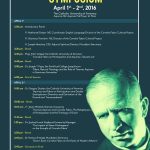
EVENT PHOTOS:
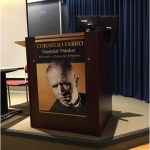 | 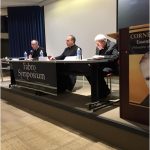 | 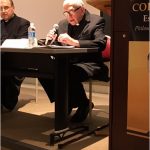 |


